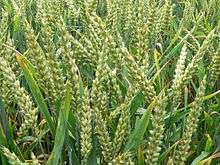Rabi crop
Rabi crops or rabi harvest are agricultural crops that are sown in winter and harvested in the spring in South Asia.[1] The term is derived from the Arabic word for "spring", which is used in the Indian subcontinent, where it is the spring harvest (also known as the "winter crop").
Etymology
The words 'kharif' and 'rabi' have their origin in Arabic. These came to be used in India with the ascent of the Mughal empire in the Indian subcontinent and have been widely used ever since.
Rabi season
The rabi crops are sown around mid-November, preferably after the monsoon rains are over, and harvesting begins in April/May. The crops are grown either with rainwater that has percolated into the ground, or using irrigation. A good rain in winter spoils the rabi crops but is good for kharif crops.
The major rabi crop in India is wheat, followed by barley, mustard, sesame and peas. Peas are harvested early, as they are ready early: Indian markets are flooded with green peas from January to March, peaking in February.
Many crops are cultivated in both kharif and rabi seasons. The agriculture crops produced in India are seasonal in nature and highly dependent on these two monsoons.[2]
Common rabi crops
- Cereals
- Seed plants
- alfalfa (also known as lucerne, Medicago sativa)
- linseed
- cumin (Cuminum cyminum, L)
- coriander (Coriandrum sativum, L)
- mustard (Brassica juncea L.)
- fenugreek (Trigonella foenumgraecum, L)
- isabgol (Plantago ovata)
- Vegetables
- carrot
- chickpea (also known as gram, Cicer arientinum)
- onion (Allium cepa, L.)
- tomato (Solanum lycopersiucum, L)
- potato (Solanum tuberosum)
mangoes
See also
References
- ↑ Balfour, Edward (1885). The Cyclopaedia of India and of Eastern and Southern Asia (3 ed.). London: Bernard Quaritch. p. 331. Archived from the original on 2014-04-15.
- ↑ Sowing time of Rabi & Kharif crop | agropedia Archived 2013-01-05 at the Wayback Machine.
External links
- India: 2003/04 Rabi Crop Assessment, US Department of Agriculture
- Pakistan Agriculture Information

